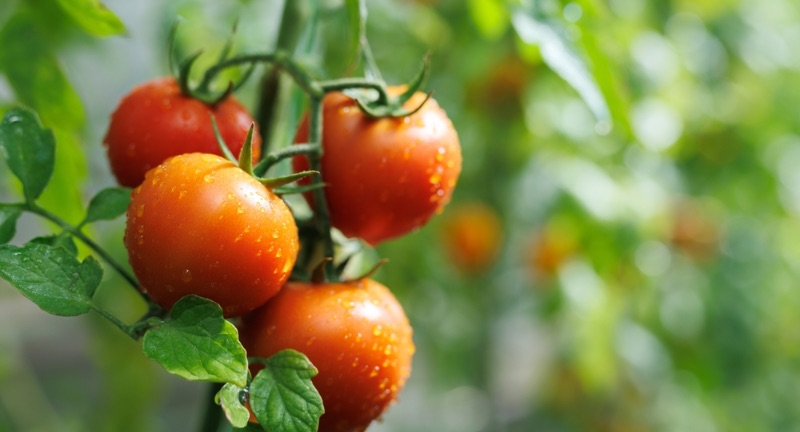EXPLORE
Fabulous Fruit: 30 Of Tomatoes Biggest Historical Accomplishments
Published
2 months agoon

Shutterstock
Tomatoes are a staple in pretty much everyone’s kitchens. This fruit is used in a number of popular dishes and could be considered one of the most versatile foods. However, tomatoes have a very interesting history that many people may not be aware of. This fruit has been through it and has even had a hand in space missions. Believe it or not, this fruit has been around the block. We are about to show you 30 of the most interesting pieces of tomato history.
Tomatoes Originated in South America

Shutterstock
Tomatoes trace their roots to the wild regions of South America, where they grew in their original, small berry-like form. These early tomatoes thrived in the warm climates of modern-day Peru, Ecuador, and northern Chile. Indigenous peoples in the region cultivated and consumed them long before European explorers arrived. This humble fruit began its journey here, setting the stage for its global culinary dominance.
The Wild Ancestor of the Tomato Is Small and Berry-Like

Shutterstock
Long before modern tomatoes adorned our salads and sauces, their wild ancestors resembled tiny, tangy berries. These small fruits were far from the plump varieties we know today, growing in clusters on wild vines. The berries evolved naturally in harsh, rugged conditions, making them resilient plants. Though modest in size, they carried the genetic blueprint for the countless tomato varieties cultivated today.
Tomatoes Were Domesticated in Mesoamerica

Shutterstock
In Mesoamerica, ancient civilizations began the process of domesticating the tomato, refining its flavor and size over generations. The Aztecs and Mayans incorporated tomatoes into their diets, transforming the fruit into a staple ingredient. This domestication paved the way for tomatoes to become larger, tastier, and more versatile. The region’s fertile lands and advanced agricultural techniques ensured tomatoes thrived and flourished.
The Aztecs Called Tomatoes “Xitomatl”

Shutterstock
The Aztecs, masters of agriculture and culture, referred to tomatoes as “xitomatl,” meaning “plump thing with a navel.” This name captured the essence of the fruit’s shape, with its round body and slight indentation. Tomatoes played a significant role in Aztec cuisine, often used in sauces, stews, and drinks. This indigenous word is the root of the modern name “tomato,” reflecting its deep cultural history.
Spanish Explorers Brought Tomatoes to Europe in the 16th Century

Shutterstock
During their explorations of the New World, Spanish conquistadors discovered the tomato and marveled at its unique qualities. They brought the fruit back to Europe in the early 16th century, where it piqued curiosity but also skepticism. Initially grown as an exotic ornamental plant, it added flair to European gardens before becoming a food staple. This transatlantic voyage marked the tomato’s first step toward global culinary fame.
Initially, Tomatoes Were Believed to Be Poisonous in Europe

Shutterstock
When tomatoes first arrived in Europe, they were met with suspicion and fear. As members of the nightshade family, they resembled certain toxic plants, leading people to assume they were poisonous. Wealthy Europeans avoided eating tomatoes, believing the acidity would leach lead from their pewter plates and cause illness. For decades, this misbelief kept tomatoes out of kitchens, limiting their potential as a culinary treasure.
Tomatoes Are Members of the Nightshade Family (Solanaceae)

Shutterstock
Tomatoes belong to the Solanaceae family, commonly known as nightshades, which includes other plants like potatoes, eggplants, and peppers. This family of plants often sparked fear in earlier times because of its association with toxic and hallucinogenic species. While some nightshades are indeed dangerous, tomatoes proved to be the exception, offering flavor and nutrition instead of poison. Today, the tomato’s place in the nightshade family is celebrated as part of a rich culinary tradition.
Italy Adopted Tomatoes as a Culinary Staple in the 17th Century

Shutterstock
In the 17th century, Italy embraced the tomato, transforming it into a cornerstone of its cuisine. Initially met with suspicion, tomatoes gradually won over Italian cooks, who saw their potential for sauces, salads, and stews. The fruit’s vibrant color and bold flavor became synonymous with Italian culinary artistry. From pizza to pasta, tomatoes became inseparable from the cultural identity of Italian food.
The Word “Tomato” Comes from the Nahuatl Word “Tomatl”

Shutterstock
The word “tomato” has its roots in the Aztec language Nahuatl, where it was originally called “tomatl.” The Aztecs used the word to describe a plump, juicy fruit that played a key role in their cuisine. As Spanish explorers brought the fruit to Europe, they adopted and altered the name to “tomate,” which eventually evolved into “tomato” in English. The name reflects the fruit’s long and fascinating journey through language and history.
Tomatoes Were Introduced to North America in the 18th Century

Shutterstock
Tomatoes made their way to North America in the 18th century, brought by European settlers who had grown accustomed to the fruit. However, many Americans were skeptical of tomatoes and avoided consuming them for decades. Over time, tomatoes gained popularity, particularly in Southern states where the warm climate helped them flourish. By the 19th century, they had become a beloved ingredient in American gardens and kitchens.
The Tomato Was Cultivated for Ornamental Purposes in Europe

Shutterstock
When tomatoes first arrived in Europe, they were viewed as ornamental plants rather than food. Their bright, jewel-like fruit made them a favorite in decorative gardens, especially among the wealthy. Europeans admired the tomato’s beauty but feared its connection to poisonous nightshades. It took years for tomatoes to make the leap from garden centerpiece to dining table staple.
Thomas Jefferson Grew Tomatoes at Monticello

Shutterstock
Thomas Jefferson, always an innovator in agriculture, cultivated tomatoes at his Monticello estate in the late 18th century. Jefferson’s passion for gardening and experimenting with crops helped introduce new vegetables, including tomatoes, to American farmers. He used tomatoes in a variety of dishes, helping dispel myths about their toxicity. His efforts paved the way for tomatoes to become a popular addition to American gardens and diets.
By the 19th Century, Tomatoes Were Widely Accepted as Food in the U.S.

Shutterstock
By the 19th century, tomatoes had overcome their reputation as a poisonous fruit and gained acceptance in the United States. American cooks began using tomatoes in soups, sauces, and other dishes, inspired by European culinary traditions. Farmers grew tomatoes widely, recognizing their versatility and profitability. From gardens to kitchens, the tomato firmly established itself as a staple in American cuisine.
The Tomato Is Botanically a Fruit but Classified as a Vegetable

Shutterstock
Botanically speaking, the tomato is a fruit because it develops from the flower of a plant and contains seeds. However, in the culinary world, it’s treated as a vegetable due to its savory flavor and use in cooking. This distinction has sparked debates for centuries, leading to legal and cultural discussions about the tomato’s true classification. Whether fruit or vegetable, tomatoes remain an indispensable part of global cuisine.
In 1893, the U.S. Supreme Court Ruled Tomatoes Were Vegetables

Shutterstock
In a surprising twist, the U.S. Supreme Court ruled in 1893 that tomatoes were vegetables, not fruits. The decision arose during a tariff dispute, as vegetables were taxed while fruits were not. Justice Horace Gray delivered the opinion, stating that tomatoes were used in savory dishes like vegetables, not desserts like fruits. This ruling cemented the tomato’s identity in the legal and culinary realms.
There Are Thousands of Tomato Varieties Globally

Shutterstock
From tiny cherry tomatoes to massive beefsteak varieties, tomatoes boast an incredible diversity of shapes, sizes, and colors. Today, there are thousands of known varieties grown across the world, each suited to different climates, cuisines, and tastes. Heirloom tomatoes, with their unique colors and rich flavors, have made a resurgence among food lovers. This vast variety highlights the tomato’s adaptability and its importance as a global crop.
Tomatoes Are a Key Ingredient in Mediterranean Cuisine

Shutterstock
The tomato is the heart of Mediterranean cuisine, adding bold flavors and vibrant color to countless dishes. From Italy’s rich pasta sauces to Greece’s fresh tomato salads, this fruit is essential to the region’s culinary identity. Tomatoes pair beautifully with olive oil, garlic, and herbs, creating iconic dishes enjoyed worldwide. Their integration into Mediterranean diets also highlights their health benefits as part of a balanced lifestyle.
The First Tomato Soup Recipe Appeared in the Late 19th Century

Shutterstock
Tomato soup, a comforting classic, first gained widespread attention in the late 19th century. Recipes began appearing in cookbooks as canned tomatoes became more accessible, providing an easy base for the soup. The iconic pairing of tomato soup and grilled cheese became a staple of American households. Its rich flavor and warmth turned tomato soup into an enduring favorite during cold winter months.
Canned Tomatoes Revolutionized Food Preservation

Shutterstock
The invention of canned tomatoes in the 19th century revolutionized food preservation and availability. Canning allowed tomatoes to be enjoyed year-round, rather than just during harvest season. This breakthrough also made tomatoes an accessible ingredient for cooks across the world, fueling creativity in the kitchen. From sauces to stews, canned tomatoes became a pantry staple that forever changed home cooking.
Tomatoes Were Taken to Asia via Spanish and Portuguese Trade Routes

Shutterstock
Spanish and Portuguese traders introduced tomatoes to Asia, where they quickly found a place in regional cuisines. In countries like India, China, and the Philippines, tomatoes were incorporated into curries, stir-fries, and stews. The fruit’s ability to enhance flavor and add color made it a favorite in both traditional and evolving dishes. Today, tomatoes are an integral part of many Asian cuisines, showcasing their global journey.
China Is the World’s Largest Producer of Tomatoes

Shutterstock
China leads the world in tomato production, growing millions of tons annually to feed both domestic and international markets. The country’s vast agricultural resources and innovative farming techniques have contributed to its dominance in tomato farming. Chinese cuisine, which often includes tomatoes in stir-fries, soups, and sauces, highlights the fruit’s versatility. As global demand for tomatoes rises, China remains at the forefront of this essential crop.
Tomatoes Were Part of NASA’s Space Farming Experiments

Shutterstock
NASA’s space farming experiments explored growing tomatoes in zero-gravity environments to sustain astronauts on long missions. These experiments demonstrated how plants, including tomatoes, could thrive in controlled conditions aboard spacecraft. Tomatoes became a symbol of innovation, showing how humanity could adapt agriculture for life beyond Earth. Their inclusion in space missions underscores the fruit’s nutritional value and potential to support future space colonization.
Florida Became a Hub for Large-Scale Tomato Farming in the 20th Century

Shutterstock
Florida emerged as a major center for large-scale tomato farming in the 20th century, thanks to its warm climate and fertile soil. Commercial farmers in the state grew tomatoes year-round, supplying fresh produce to markets across the United States. Florida’s tomatoes played a key role in feeding growing urban populations and shaping modern agriculture. Today, the state remains a vital part of America’s tomato industry.
Heirloom Tomatoes Have Regained Popularity in Modern Agriculture

Shutterstock
Heirloom tomatoes, prized for their unique flavors, colors, and histories, have made a comeback in modern agriculture. Unlike commercially bred tomatoes, heirlooms are open-pollinated and often passed down through generations of farmers. Their rich taste and striking appearance have captivated chefs and home gardeners alike. This resurgence reflects a growing interest in heritage foods and sustainable farming practices.
Tomatoes Are Used to Produce Ketchup, One of the Most Popular Condiments

Shutterstock
Ketchup, one of the world’s most beloved condiments, owes its existence to tomatoes. First developed in the 19th century, tomato ketchup became a household staple for its sweet, tangy flavor. It pairs perfectly with everything from fries to burgers, cementing its place in global fast food culture. Millions of bottles are consumed annually, showcasing the tomato’s versatility and enduring appeal.
The First Genetically Modified Tomato Was the Flavr Savr, Introduced in 1994

Shutterstock
In 1994, the Flavr Savr became the first genetically modified tomato to be approved for commercial sale. Scientists designed this tomato to stay fresher for longer, addressing issues of ripening and spoilage. While the Flavr Savr sparked debates about genetically modified foods, it also marked a milestone in agricultural science. The technology behind it paved the way for future innovations in crop improvement.
Tomatoes Are Packed with the Antioxidant Lycopene

Shutterstock
Tomatoes are rich in lycopene, a powerful antioxidant that gives them their vibrant red color. Studies have shown that lycopene can help reduce the risk of heart disease, cancer, and other chronic illnesses. Cooking tomatoes, like in sauces or soups, actually increases the bioavailability of lycopene, making it easier for the body to absorb. This health-boosting compound highlights why tomatoes are more than just delicious—they’re nutritional powerhouses.
Tomatoes Play a Major Role in the Global Economy

Shutterstock
Tomatoes are one of the most economically significant crops in the world, supporting millions of farmers and businesses. They are grown on a massive scale, both for fresh consumption and processing into products like sauces, pastes, and juices. The global tomato industry generates billions of dollars annually, with countries like China, the U.S., and Italy leading production. Tomatoes connect economies, cultures, and cuisines across the globe.
Tomato Festivals Celebrate This Beloved Fruit Worldwide

Shutterstock
Tomato festivals are held worldwide to honor this beloved fruit in fun and unique ways. Spain’s famous La Tomatina festival sees thousands of people participate in a massive tomato fight, turning the streets into rivers of red pulp. In the United States, tomato festivals celebrate heirloom varieties, culinary creations, and local farmers. These events bring communities together, showcasing the tomato’s cultural and culinary importance.
Tomatoes Can Be Grown Indoors and in Urban Settings

Shutterstock
Tomatoes are one of the easiest plants to grow indoors or in small urban spaces, making them a favorite among home gardeners. Compact varieties like cherry tomatoes thrive in pots, on balconies, or even in hydroponic systems. With proper light and care, tomatoes can be grown year-round, offering fresh produce straight from the windowsill. Their adaptability makes them a symbol of sustainability in urban gardening.
Conclusion

Shutterstock
Tomatoes have journeyed through time and across continents, leaving their mark as they go. From ancient civilizations to modern kitchens, this fruit has proven its popularity. Tomatoes have built an impressive legacy for themselves, and because of this, we are probably not getting rid of them any time soon. Sorry, tomato haters. All these facts really make us wonder what the next 100 years look like for tomatoes.
Related Topics:

More From Lifestylogy
-


Your How To Guide To Gardening
-


25 Fruits That Have A Sour Reputation And Taste
-


25 Green Vegetables That You Should Be Eating
-


25 Most Classic Cookie Recipes To Make For The Holidays
-


Hardwood Is The Best: Here’s Why
-


20 Vitamins That Make The Most Impact On Your Health
-


25 Herbs That Are Essential To Chinese Herbal Medicine That…
-


25 Ways To Incorporate More Magnesium Into Your Diet
-


25 Things Only Servers Understand